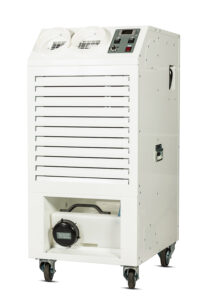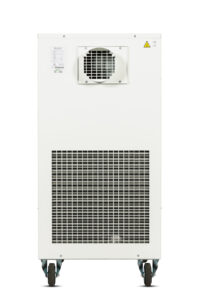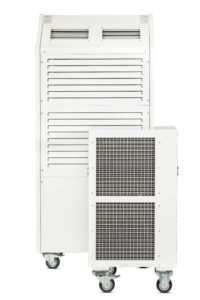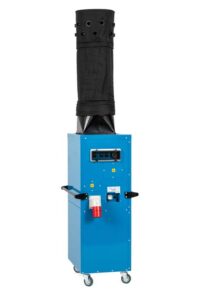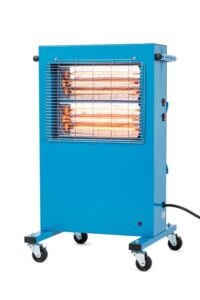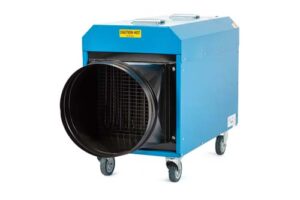EVENT COOLING AND HEATING: BACK TO THE BASICS
When it comes to party planning using the right portable cooling or heating equipment is essential to the success of an event, after all, you don’t want guests sweating or shivering throughout the presentations or speeches! Listed below are a few hints and tips to help you provide a comfortable climate in tents, temporary structures and other event locations.
PORTABLE COOLING.
Multiple portable air conditioning units of 3.5 to 10kW capacity can adequately do the job of providing enough cooling for an event. These water or air-cooled units may be located indoors or out (providing suitable protection from the weather is provided) depending on noise and space constraints. Some clients also prefer to specify two or three of the smaller portable units instead of a single larger machine so as not to put all their eggs in one basket so to speak, that way should anything happen to one of the units there are more already on site to help provide continued cooling.
As a general rule you should plan on using 3.5kW of cooling for every 9 to 14M2, that’s not a precise measurement by any means as there are many variables involved in specifying the correct cooling load, but it is a very useful rule of thumb. That might seem to give you a lot of cooling, but please bear in mind that it will be needed because marquee walls offer virtually no insulation and people are prone to leaving doors open, especially when it’s hot. Whether you opt for the low or high end of this range will not only depend on the calculated heat load but also other factors such as the time of day or evening, predicted temperatures, number of people in the space, type of activity (dancing etc), and the presence of anything that generates heat such as spotlights of cooking equipment. Since comfort is a large part of the success of an event then we feel it’s best to build a little extra cooling capacity at the planning stage as it’s a lot easier to turn a portable air conditioning unit off at midnight if it’s getting a little chilly than it is to find another one immediately available if everyone’s too warm!
If the event is to take place indoors, the formula changes to about 3.5kW of cooling for every 37 to 55M2. Again, the heat load must be calculated with the above mentioned factors taken into account to help determine how much cooling is needed.
Another popular option for outdoor event cooling in large open areas or open-sided tents is evaporative cooling. Evaporative coolers require water, either from an internal tank or a via a standard garden hose can be hooked up to the unit to provide an automatic water fill. If you’re using the internal tank then these must be manually filled up and the water level is monitored to ensure they don’t run dry. A fan in the unit pulls the air across the cooling pad which will remove heat from the air before it’s redistributed by the fan.
Evaporative coolers are simple and cost-effective, especially for events where power is limited or there’s a large open space. Though their use is associated more with desert climates, evaporative coolers can usually bring a 2.5- to 8⁰C temperature reduction, perhaps even more in high humidity environments. Depending on the unit you’ve got it might also be possible to connect your evaporative cooler to a duct sock that runs down the middle of the marquee to help distribute the air more evenly throughout the tent. Another useful trick is to put ice or cooled water into the evaporative cooler to enhance the cooling capacity. It’s important to note that evaporative coolers do not offer the level of performance and comfort control associated with air conditioning, but they still provide a good way to cool on a smaller budget.
Keeping the event cooling equipment outside the tent is often preferable if possible as it helps reduce noise and keeps the equipment away from any busy fingers. The area should be as sealed as possible to shelter equipment from wet weather, unless it’s suitably IP rated. As you bring the cooled outdoor air into the tent, you should try to direct it either up or down to avoid blasting guests and tables. Cold air will fall and form a layer of comfort here before it is drawn back into the return air duct to be re-cooled. With this approach, smaller units positioned around the perimeter of the marquee will be advantageous as it will give a more even and consistent cooling. An alternative method is to create a positive pressure (where the pressure inside the tent is greater than that outside) within the tent with no return ducts, which is a very common method to deliver even cooling distribution throughout the venue. The best approach will of course depend on budget, venue size, conditions outside, and the other variable factors detailed above.
Whether it’s heating or cooling, climate control equipment requires a lot of power so the supply and distribution of it is an important consideration. Smaller events might draw electricity from an adjacent building or home so other loads on the ring main must be factored in, whereas larger events might require a 3 phase supply or even a dedicated generator to support adequate tent climate control. Another important factor to bear in mind is the length and amount of electrical cable required to distribute the power to all the equipment. When calculating just how much cable you need please remember that the greater the length, the bigger the diameter needs to be to maintain voltage and current draw.
Finally, once you confident you’ve made all the calculations please don’t forget the cable ramps to hide the cables and prevent trip hazards.
PORTABLE HEATING.
To heat an event, the same general principles for cooling apply to equipment sizing and location. However, the equipment itself is quite different.
Sometimes for larger events indirect-fired heaters – sited outside the tent or other party areas – can be used. These units contain a heat exchanger, which encloses a diesel or propane gas heating source and a fan that blows across the exchanger producing warm air. The problems with any gas or diesel heaters are primarily the smell, unpleasant fumes and the need to provide a separate fuel source such as a 1000L diesel tank.
Indirect heaters should not be confused with direct-fired gas heaters, sometimes also called construction heaters. With direct-fired units there is no heat exchanger, the air is simply blown across a natural gas or propane flame and into the area to be heated. The biggest problem with direct heating is that the open flame produces toxic emissions, so safety issues are a big concern, and therefore these units are only suitable for use in very well-ventilated open areas. They also have to be sited within the actual area being heated rather than outside so the likelihood of incident is increased, especially if you have party goers who might have ‘over indulged’.
Large industrial electric fan heaters are often considered the better option as they provide clean, dry, safe heat free from emissions. Portable electric heaters as they are known can also be powered by an existing source or the generators usually found at larger events to provide power for the music, lights and kitchen etc, so not only are they safe but there’s also no need to supply dedicated heating fuel.
Though you will probably not deliver and set up the heating or cooling equipment until the morning of the event, it pays to plan ahead with the customer. There are many factors that will impact portable equipment selection, so to ensure success, you’ll always want to develop a thorough and well-thought-out plan for all of the equipment you’re supplying.
For expert assistance with your event climate control then please do not hesitate to get in touch and we can put you in contact with one of our specialist distributors, with many years experience they’re all able to offer a detailed and comprehensive service.
